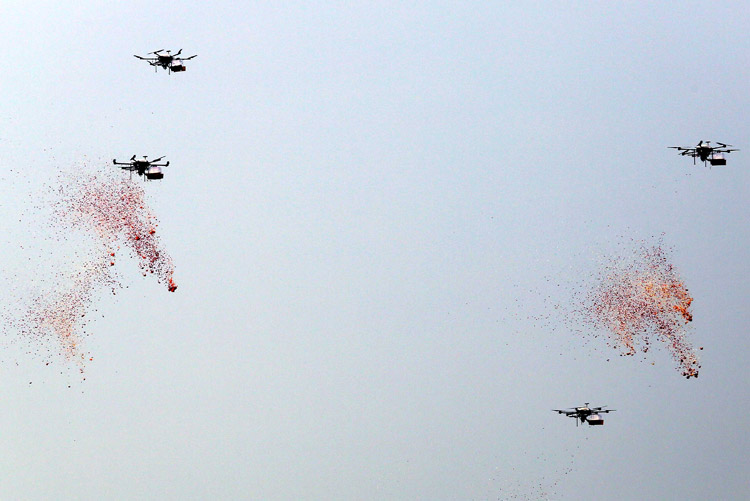INDIAN ARMED FORCES CHIEFS ON OUR RELENTLESS AND FOCUSED PUBLISHING EFFORTS

The insightful articles, inspiring narrations and analytical perspectives presented by the Editorial Team, establish an alluring connect with the reader. My compliments and best wishes to SP Guide Publications.

"Over the past 60 years, the growth of SP Guide Publications has mirrored the rising stature of Indian Navy. Its well-researched and informative magazines on Defence and Aerospace sector have served to shape an educated opinion of our military personnel, policy makers and the public alike. I wish SP's Publication team continued success, fair winds and following seas in all future endeavour!"

Since, its inception in 1964, SP Guide Publications has consistently demonstrated commitment to high-quality journalism in the aerospace and defence sectors, earning a well-deserved reputation as Asia's largest media house in this domain. I wish SP Guide Publications continued success in its pursuit of excellence.
Army's Offensive Drone Swarm
Indian Army has ordered offensive swarming drone systems under the emergency procurement (EP) powers and eventually aims at offensive swarm drone capability of 1,000 drones
 |
The Author is Former Director General of Information Systems and A Special Forces Veteran, Indian Army |

It was reported in these columns recently that the Indian Navy is exploring ways to utilise underwater swarm drones (USVs) and is currently working in conjunction with an indigenous start-up Sagar Defence Engineering Ltd (SDEL) to develop the concept. Importantly, the first prototype USV for a weaponised 12-boat swarm ordered by the Indian Navy (IN) is to be demonstrated by the end of this year. SDEL has been working on complete indigenisation of USVs for the past decade, including improved autonomy, electric propulsion and battery capacity.
The news now is that the Indian Army has already inducted offensive swarm drones capability. It may be recalled that on January 15, 2021 (Army Day), the Army had showcased for the first time swarm drone capability by carrying out a simulated Kamikaze attack on targets like enemy tanks, fuel depots, terror hideout and radar positions and some other targets as part of the Army Day Parade in Delhi Cantonment. In this demonstration, the Army had showcased 75 drones including the mother unmanned aerial vehicles (UAVs) releasing the smaller swarm drone systems. But the plan is for acquiring larger offensive swarm drones capability, spearheaded by the Army Design Bureau which is charged with induction of futuristic technologies in the Army.
Swarm drone attacks are very difficult to counter using conventional defences and can overwhelm the defenders to a great extent
Swarm drones have been used in the Armenia-Azerbaijan conflict in Ngorno Karabakh and even by terrorist and radical organisations like the Islamic State in Iraq-Syria and Houthis against oil facilities of Saudi Arabia. Their use has become more prominent in the ongoing war in Ukraine from both sides with the US-led West arming Ukraine. Swarm drone attacks are very difficult to counter using conventional defences and can overwhelm the defenders to a great extent. Swarm drones offer a highly asymmetric value of return and very significantly, drones working together and aiming for target saturation through numbers not only have a greater chance to achieve mission success, but also impose a high cost penalty on the air defence elements of the defender.

The offensive swarming drones system consists of a group of drones which cooperate with each other using advanced autonomy, computing, communication and artificial intelligence (AI) protocols to execute various mission objectives with minimal human intervention. The drones exhibit self-organising behaviour, collision avoidance between the drones and obstacle avoidance with terrain.
The Army’s swarm drones capability is first being inducted into the mechanised forces where they will be employed for surveillance and attack missions
In terms of mission success, swarm drones have in-built redundancy, in that, if a drone becomes a casualty for whatever reason including due to enemy action, the swarm automatically re-arranges itself since each drone has a mind of its own and capable of taking collective decisions. There is no designated leader and instead every drone is a leader. The mission, therefore, is not jeopardized.
News reports reveal that the Army had ordered offensive swarming drone systems under the emergency procurement (EP) powers and the Bengaluru based start up ‘NewSpace Research & Technologies’ began supplying the systems of 100 drones in February 2023, coinciding with Aero India 2023. This swarm drone system is capable of hitting targets at least 50 kms deep inside enemy territory. According to media, the Army eventually aims at offensive swarm drone capability of 1,000 drones.

Army’s offensive swarm drones systems are capable of carrying bombs of a certain weight and can home onto a target, like moving armoured columns, artillery positions, and enemy bunkers and fortifications for attacking them. In addition to the heterogeneous swarm drone system delivered by NewSpace Research & Technologies, the Army is also procuring homogeneous swarm drones from ‘Raphe Mphibr’, a NOIDA headquartered private company in Uttar Pradesh. The Army’s swarm drones capability is first being inducted into the mechanised forces where they will be employed for surveillance and attack missions.
Induction of indigenous offensive swarm drones into the Army demonstrates that India is capable of taking the lead in this sphere
The Chinese aggression in Eastern Ladakh during 2020 was a rude shock, resulting in intrusions, loss of control of large tracts of territory and shifting of the Line of Actual Control (LAC) westwards. But one positive fallout was the boost to defence research and development (R&D), innovations and opening up the defence sector to startups and the private industry as part of Atmanirbhar Bharat and ‘Make in India’. Induction of indigenous offensive swarm drones into the Army demonstrates that India is capable of taking the lead in this sphere – operationally deploying swarm drones of this size in the battlefield, this being one of the first instances, if not the first. The Indian Air Force (IAF) is also scheduled to induct operational swarming unmanned aerial systems (UAS) in the near future.





